In this chapter, we study furniture in depth in order to better estimate their precise origin and carry out accurate dating.
“SUNG SUN I” BANDAJI.
This piece of furniture, bought in China in the mid-90s, probably came from North Korea. In the late ’80s, many pieces circulated between North Korea and China via the northern border of north-Korea and the provinces of Liaoning and Jilin in China.
The “Sung Sun I” style, from the northern part of the peninsula, is characterized by fine, lacelike ironwork on the front of the chest.

We found this unrestored piece of furniture in good condition. Not a single piece was missing. It was rare to come across furniture like this, as most of it required extensive restoration, replacement of missing parts, cleaning and reconditioning of the finish.
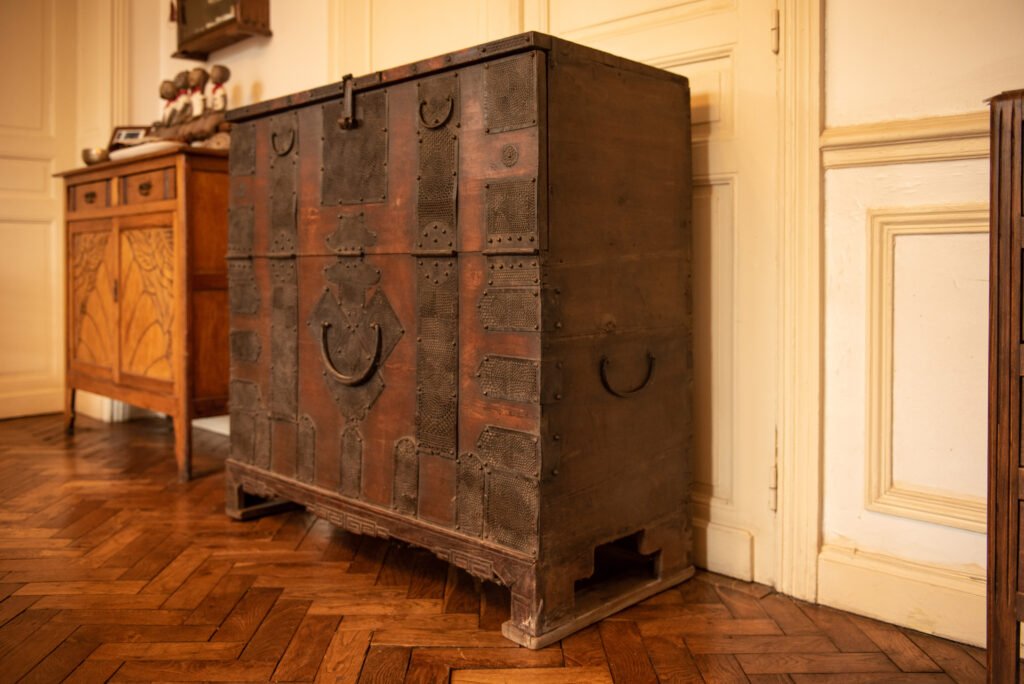
In this particular case, examination of the wood revealed the use of elm (front part), rather rare for this type of piece. For most of them, linden or pine was commonly used. Its fine grain was particularly attractive with a very nice original patina.
The furniture also rested on a lightly-decorated original base of good quality. This design is known as “Madae” type.
Closer examination revealed the absence of nails. The furniture had been assembled using the traditional jointing technique employed by the Korean carpenters of the Joseon dynasty.
Woods: Elm (front part), pine (back and sides).
Dimension: H. 103cm, W. 107cm, D. 47cm.

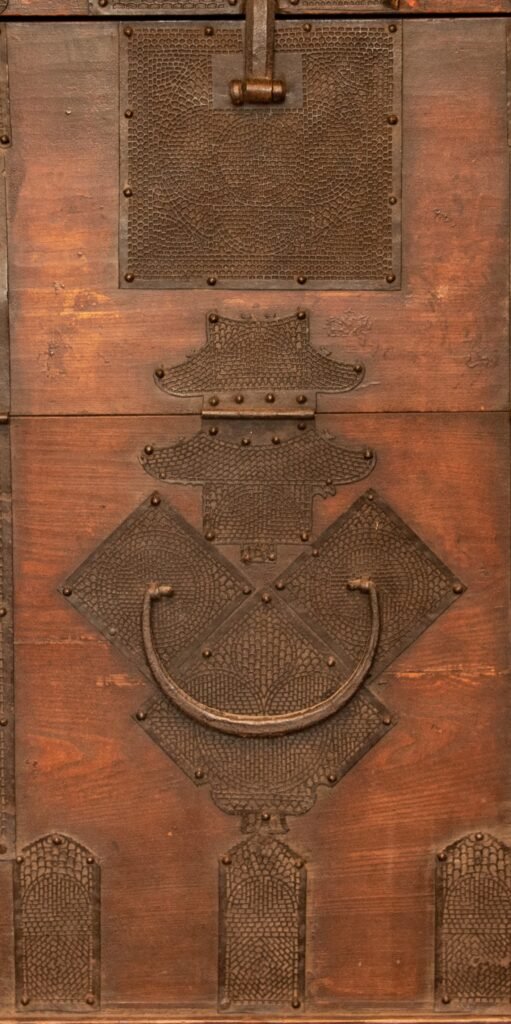


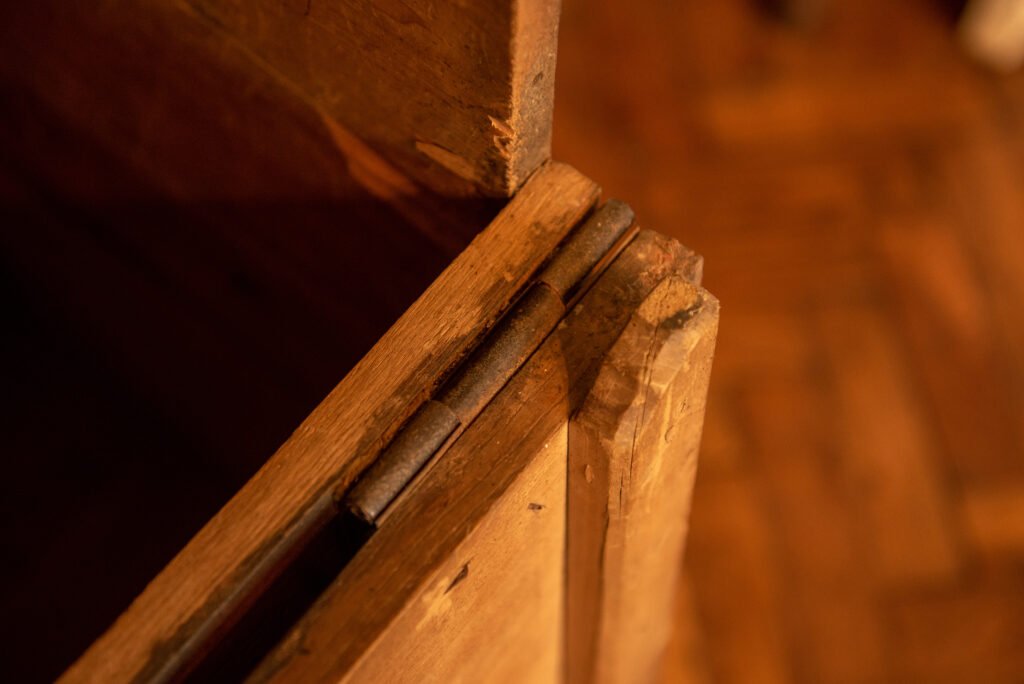



Based on its condition and careful examination of the hinges, we estimate that this piece of furniture probably dates from the late 19th century. It probably belonged to a relatively wealthy family and is typical of the Pyongan province in the north-west of the peninsula.
BOOKCHEST – FURNITURE THAT TELLS STORIES.
Furniture from every era serves as a visible reminder of the customs and traditions prevalent during the period in which it was designed. The dimensions, color finishes, and decorative motifs of these pieces provide valuable clues about the tastes of their owners.
In Korea, for example, we observe that furniture intended for women featured more decorative elements and was often more colorful. Men’s furniture, on the other hand, adhered to the principle of sobriety dear to Confucian principles.
To illustrate this point, let’s take a look at this piece of furniture displayed at the National Folk Museum of Korea in Seoul.


This large chest is made of pine wood covered with a dark stain. Dimensions are H. 128cm, W. 150,5cm, D. 38,5cm.
It is composed of two floors opened by double doors. The upper part of the cabinet has raised edges, a characteristic feature of scholar’s chests. The upturned ends are not only decorative but help to prevent scrolls from rolling off the chest. It stands on elaborate “cabriole” feet.
Furniture for books and document storage are distinguished by relatively subdued woods and fittings.
DECORATIVE MOTIFS.
A more detailed analysis of the decorative motifs reveals certain characteristics of Korean society at the time.
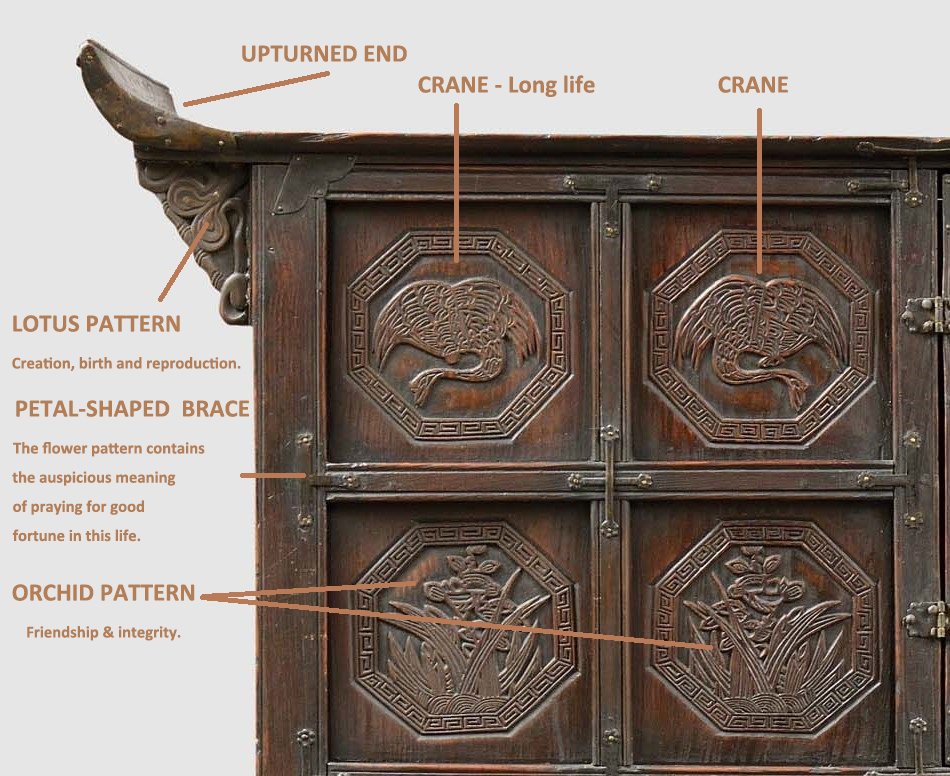

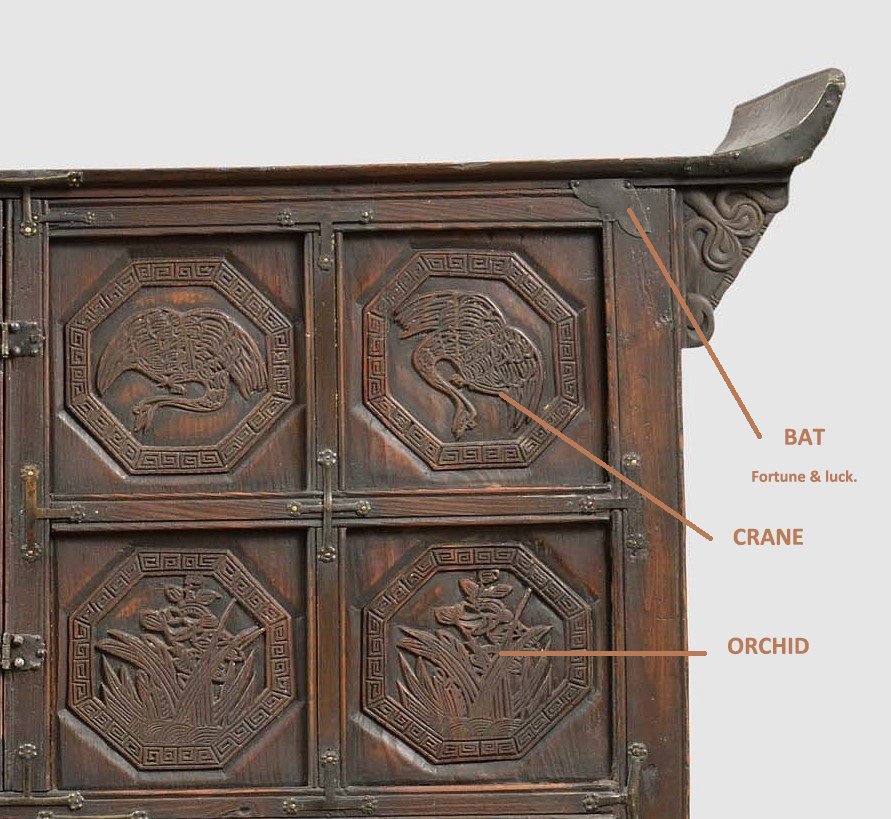

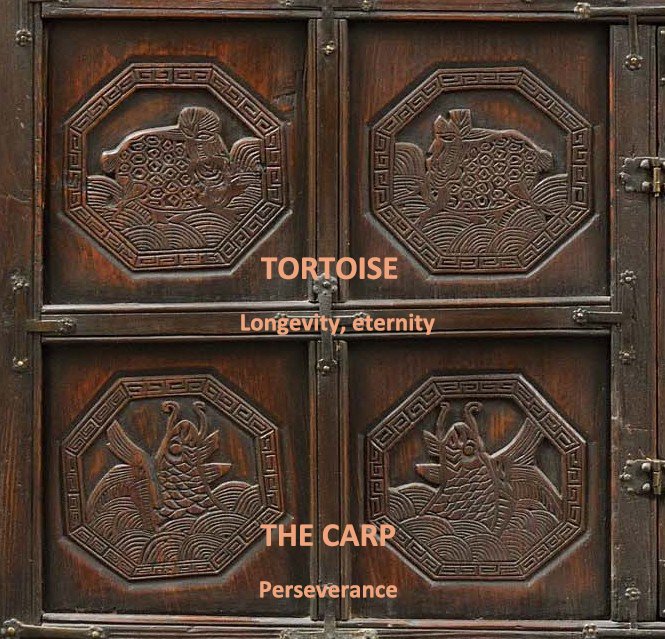
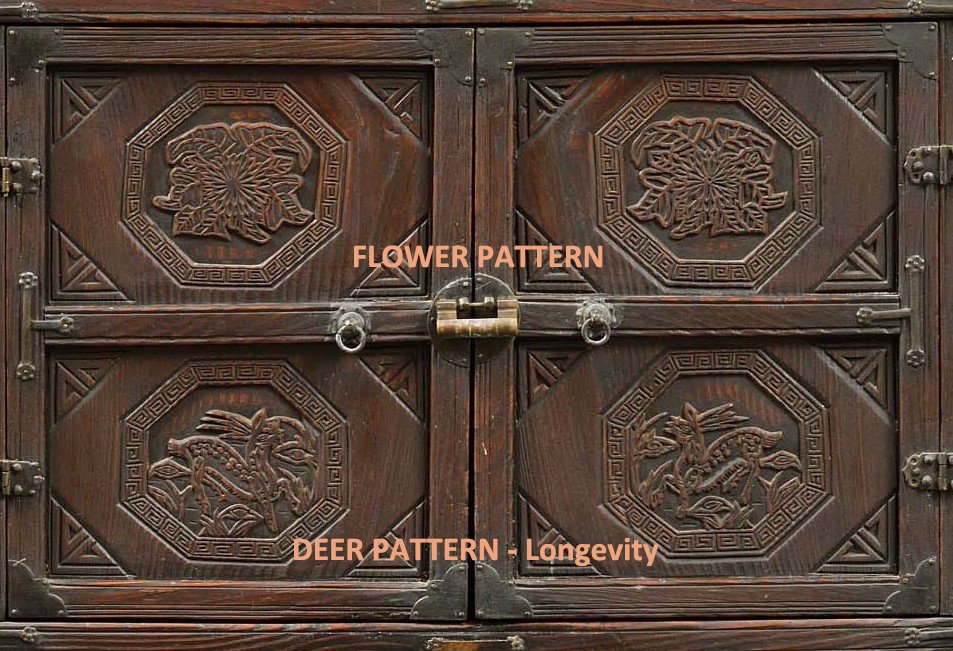


This piece of furniture, richly decorated with auspicious motifs and dear to the heart of the Korean scholar, is a perfect illustration of the Confucian ideology that dominated society during the Joseon dynasty. The motifs shown above are mostly of Chinese origin but were used extensively in Korean art of the period. They symbolize good fortune, integrity, long life, prosperity, and the wish for male offspring, as well as perseverance.
EARLY PERIOD BOOK CHESTS.

H. 102,2cm, W. 115,7cm, D. 43cm.
179th Art Auction, June 24, 2024. Seoul Korea
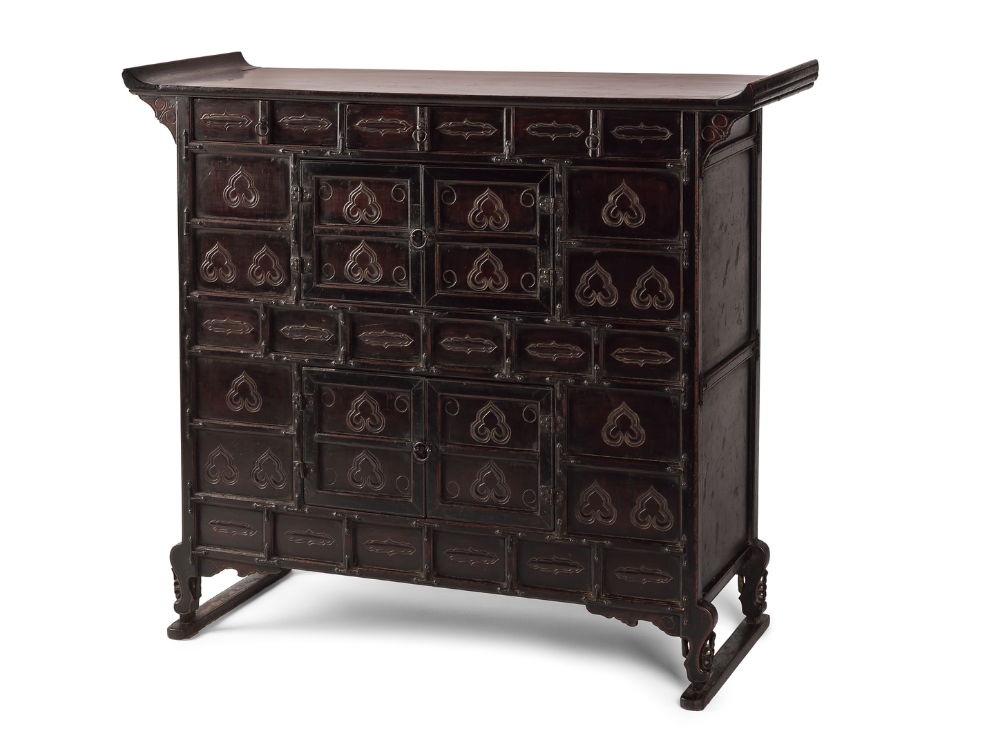

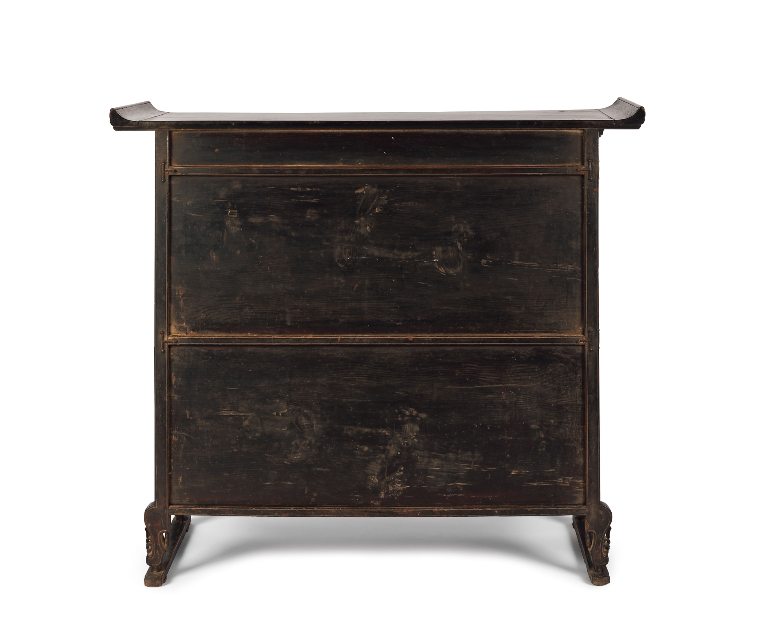
This is a Gyeongsang-style two-story bookshelf featuring scroll top panel ends and foot-shaped legs, retaining the elegant appearance characteristic of wooden furniture from the Joseon Dynasty. The top and frame are made of pear wood, known for its rigidity, while the front is crafted from ginkgo wood, which is less prone to warping. The construction and joint structure are particularly outstanding. There are doors at both the top and bottom sections, and the top compartment includes additional drawers for easy storage.
The bookshelf was constructed by building the front frame first and then inserting panels between it, a technique often used in high-end furniture to prevent the defects caused by wood contraction and expansion, as well as to reduce the weight of the furniture. The sides and back are divided according to the internal composition. Arabesque-style wind holes are placed next to the pillars under the bottom, with additional arabesque-shaped and bamboo-shaped wind holes on the legs for added decorativeness. The Ansangmun pattern is engraved on the front compartment, while the Yeouidomun pattern adorns the back panel. A simple cast iron fitting is attached to give it a minimalist feel.
A bookshelf like this is designed to hold heavy books and stationery, so the use of hard wood, a sturdy texture, and efficient spatial composition are essential elements. It was manufactured with all these considerations in mind, and its form has remained intact even after many years of use. This rare piece of wooden furniture dates back to the 17th century and is considered a representative example of a scholarly bookshelf, featuring a decorative yet restrained and honest style.
BOOK CHEST, COIN CHEST OR GRAIN CHEST?

Collection: National Folk Museum, Seoul.

Collection: National Folk Museum, Seoul.
Furniture for storing grains, dishes, etc., takes the form of a rectangular parallelepiped with legs. It is a top-closing type, made by inserting a door plate at the top and connecting a hinge so that it can be opened and closed upward. The legs are connected to the body’s top and are made by attaching fittings.


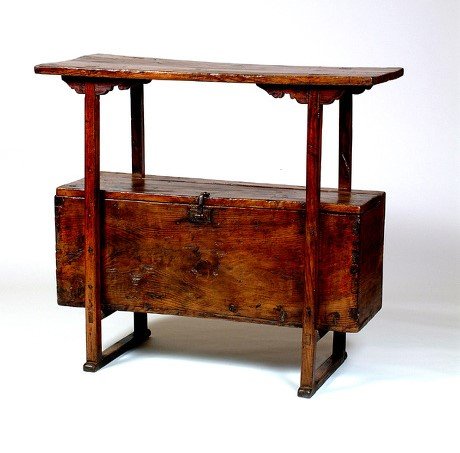
THE BRIDE’S DOWRY MULTI-LEVEL CLOTHING CHEST.
The bride’s dowry chest, known as “Ham,” was a traditional Korean wedding chest used to store and display the bride’s trousseau. It was typically made of wood, often with intricate carvings or decorations. These boxes were not only functional but also symbolized the family’s wealth and the bride’s status. They were an important part of traditional Korean wedding ceremonies, reflecting the cultural importance placed on weddings and familial heritage.
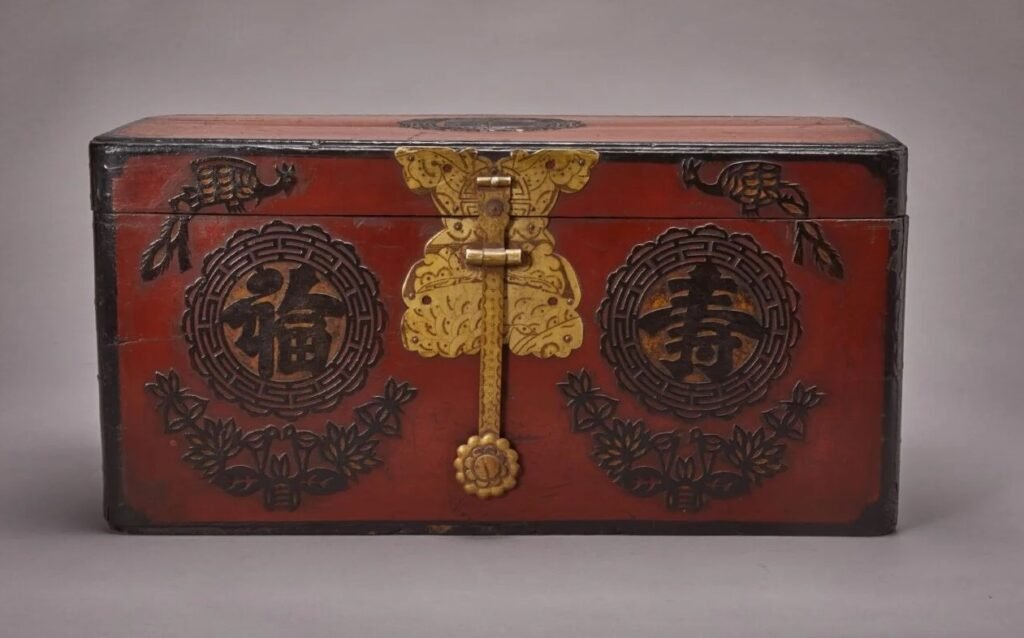
H. 28cm, W. 56,5cm, D. 28cm.
Collection: Bupyeong Station, Korea,
Aside from simple boxes, larger pieces of furniture such as multi-level clothing chests could be commissioned by wealthy families for the same purpose.

Lacquer on wood, zelkova burl panels, brass fittings. Early 20th century. H. 160,3cm, W. 113,7cm, D. 56.5cm.
Collection: BROOKLYN MUSEUM. 200 Eastern Parkway,
Brooklyn, New York. USA.
Most household goods were stored in the women’s quarters in large cabinets and chests. These were typically the largest and most costly pieces of furniture in the home and were given to the couple at the time of their wedding. The taller piece shown here is known as a “mandarin duck” cabinet because of the paired openings at the base. Mandarin ducks mate for life, so they are emblematic of the number two and of happy marriages.
The name “Mandarin duck cabinet” comes from the double doors at the bottom. This cabinet was mainly included in a bride’s dowry, symbolizing good wishes for a long and happy marriage. This particular cabinet exhibits typical features of Gyeonggi region mandarin duck cabinets. Mandarin ducks mate for life and often travel in pairs, so many Asian cultures associate them with pairing and marriage.
According to the Korean Art Collection in the Brooklyn Museum catalogue, the cabinet is made of red and black lacquered wood with zelkova burl panels, pine sides, and back panels, and brass fittings. This large, rectangular chest, with its many panels, moldings, and ornate hardware, indicates it was made for the women’s quarters in the home of a royal family member. Red and black lacquer chests were usually reserved for royalty.
Confucianism required upper-class Yi Dynasty men and women to maintain separate living quarters within the same house, eating and sleeping separately, though husbands could visit their wives at night. The chest rests on low, slightly curved feet, painted dull red and bound at the corners with brass plaques. The front is divided into two lower compartments, two larger upper compartments, and a top row of small flat drawers, each with double doors that hinge at the sides. The main frames and most moldings are black lacquer, while the frames of the upper and middle doors are red lacquer. The door panels and fronts of the small drawers are zelkova burl wood. The sides and back are undecorated pine. The brass fittings are highly elaborate, with complex ornamental openwork, and the chest’s main panels are adorned with decorative brass plaques depicting plants and songbirds. The interior is papered.

H. 146cm, W. 90cm, D. 42cm.
Auction: Chorley’s, Nr Cranham, Gloucestershire, UK. July 23, 2024. SOLD for 350 GBP


Estimate$500-$800 Sold for$450
New Orleans Auction Galleries
New Orleans, LA, United States May 18, 2014.


The single-case cabinet built with rounded framing members to the front surrounding the four small drawers at the top and floating panels above and below the three pairs of doors fronting the storage compartments; brass hardware and decorative plaques depicting flower and bird subjects.
59 x 47 x 22 3/4in (150 x 119.5 x 58cm)
BONHAMS.
Asian Decorative Arts
28 Jul 2009, 10:00 PDT
San Francisco
Sold for US$ 854

A 19th-century Korean elm cabinet with brass decoration.
The cabinet features various drawers, cupboards, and recessed panels. It has an elm top with a molded edge adorned with pierced brass decoration at the corners. Below this are four small drawers with brass handles and applied brass decoration.
Further down is a cupboard with two doors secured by circular brass lock plates and brass hinges, decorated with brass birds and floral motifs.
Below these are four small recessed panels with brass floral decoration, leading to another cupboard with two doors featuring similar brass decoration.
At the base, there are four small recessed panels with brass floral decoration, leading to a pair of cupboards, each with two doors adorned with shaped and pierced brass lock plates and hinges with “manja” patterns. Inside are small drawers with further recessed panels below, ending with a molded edge.
The cabinet is supported by a shaped frieze on the front, sides, and back, with shaped feet and applied brass pierced “manja” decoration.
The manja symbol or swastika has been important in Hindu and Buddhist cultures for millennia, symbolizing well-being, good luck, and eternity. In Buddhism, it represents good fortune, abundance, and promotes goodwill and compassion towards all living beings.
Courtesy of: LVS Decorative Arts Suffolk, United Kingdom.






In summary, this large piece of furniture, often made from elm wood, was extensively covered with yellow brass metal decorations featuring similar motifs such as birds and flower bouquets. Originating from the central region, particularly the Gyeonggi province where the capital was located, it most likely appeared in the late 19th century and early 20th century. Its decoration indicates that it was a piece of furniture used in the women’s quarters for storing clothes and was presented to the future bride on the occasion of her marriage.


Wonderful information provided!